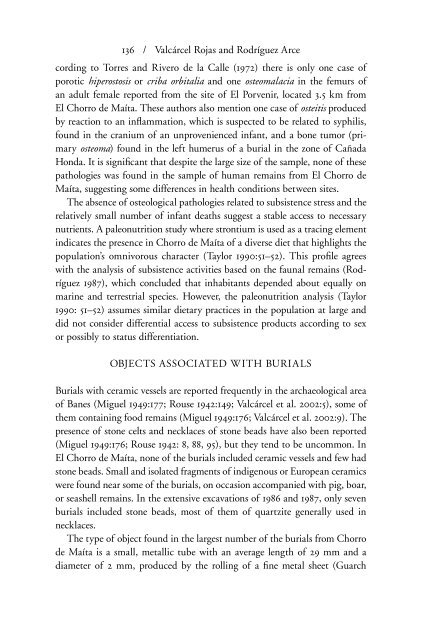Dialogues in Cuban Archaeology
by L. Antonio Curet, Shannon Lee Dawdy, and Gabino La Rosa Corzo
by L. Antonio Curet, Shannon Lee Dawdy, and Gabino La Rosa Corzo
You also want an ePaper? Increase the reach of your titles
YUMPU automatically turns print PDFs into web optimized ePapers that Google loves.
136 / Valcárcel Rojas and Rodríguez Arce<br />
cord<strong>in</strong>g to Torres and Rivero de la Calle (1972) there is only one case of<br />
porotic hiperostosis or criba orbitalia and one osteomalacia <strong>in</strong> the femurs of<br />
an adult female reported from the site of El Porvenir, located 3.5 km from<br />
El Chorro de Maíta. These authors also mention one case of osteitis produced<br />
by reaction to an <strong>in</strong>®ammation, which is suspected to be related to syphilis,<br />
found <strong>in</strong> the cranium of an unprovenienced <strong>in</strong>fant, and a bone tumor (primary<br />
osteoma) found <strong>in</strong> the left humerus of a burial <strong>in</strong> the zone of Cañada<br />
Honda. It is signi¤cant that despite the large size of the sample, none of these<br />
pathologies was found <strong>in</strong> the sample of human rema<strong>in</strong>s from El Chorro de<br />
Maíta, suggest<strong>in</strong>g some differences <strong>in</strong> health conditions between sites.<br />
The absence of osteological pathologies related to subsistence stress and the<br />
relatively small number of <strong>in</strong>fant deaths suggest a stable access to necessary<br />
nutrients. A paleonutrition study where strontium is used as a trac<strong>in</strong>g element<br />
<strong>in</strong>dicates the presence <strong>in</strong> Chorro de Maíta of a diverse diet that highlights the<br />
population’s omnivorous character (Taylor 1990:51–52). This pro¤le agrees<br />
with the analysis of subsistence activities based on the faunal rema<strong>in</strong>s (Rodríguez<br />
1987), which concluded that <strong>in</strong>habitants depended about equally on<br />
mar<strong>in</strong>e and terrestrial species. However, the paleonutrition analysis (Taylor<br />
1990: 51–52) assumes similar dietary practices <strong>in</strong> the population at large and<br />
did not consider differential access to subsistence products accord<strong>in</strong>g to sex<br />
or possibly to status differentiation.<br />
OBJECTS ASSOCIATED WITH BURIALS<br />
Burials with ceramic vessels are reported frequently <strong>in</strong> the archaeological area<br />
of Banes (Miguel 1949:177; Rouse 1942:149; Valcárcel et al. 2002:5), some of<br />
them conta<strong>in</strong><strong>in</strong>g food rema<strong>in</strong>s (Miguel 1949:176; Valcárcel et al. 2002:9). The<br />
presence of stone celts and necklaces of stone beads have also been reported<br />
(Miguel 1949:176; Rouse 1942: 8, 88, 95), but they tend to be uncommon. In<br />
El Chorro de Maíta, none of the burials <strong>in</strong>cluded ceramic vessels and few had<br />
stone beads. Small and isolated fragments of <strong>in</strong>digenous or European ceramics<br />
were found near some of the burials, on occasion accompanied with pig, boar,<br />
or seashell rema<strong>in</strong>s. In the extensive excavations of 1986 and 1987, only seven<br />
burials <strong>in</strong>cluded stone beads, most of them of quartzite generally used <strong>in</strong><br />
necklaces.<br />
The type of object found <strong>in</strong> the largest number of the burials from Chorro<br />
de Maíta is a small, metallic tube with an average length of 29 mm and a<br />
diameter of 2 mm, produced by the roll<strong>in</strong>g of a ¤ne metal sheet (Guarch


















